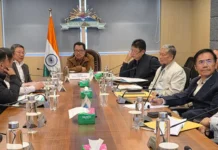[ S Umpo ]
The following piece is an endeavour to understand the perspective of the courts in matters concerning the conversion of a person from a tribal society to a different religion. The question that yours truly herein tries to submit is as to whether a person who belongs to schedule tribe (ST) loses his status as ST upon his conversion to another religion or not.
Who is a tribal?
The division bench of the Supreme Court in NE Horo v Jahanara Jaipal Singh stated that a “… tribe is a collection of families bearing a common name, speaking a common dialect, occupying or professing to occupy a common territory….” And therefore, tribals have certain common traits of uniform culture and way of life and are occupied in certain contiguous territory. They often belong to a common descent.
The court therein notes that the tribals today are not immune to the change that has occurred in today’s world guided by different considerations. The fragile tribal society cannot be immune to the changes effected by modernisation, urbanisation, industrialisation, and the education around them. Accordingly, their beliefs, customs, and traditions have undergone a change.
Tribes and tribal community
The court in NE Horo also observed that the Constitution permits the president to notify an ST status to ‘tribes’ or ‘tribal communities’. The court therefore was of the belief that the expression ‘tribal communities’ is of wide connotation, so as to include within it people who do not strictly belong to that tribe. The court elaborated it by stating that a person may also be eligible to be given an ST status even if he is not born in that very tribe. For example, through marriage.
A person who is not born to a tribal family may be notified to be an ST, per the court, if one is married to a person of a tribal family, with observance of tribal formalities, and recognition is accorded to such a relationship by the elders of the community. Thus, though one may not belong specifically to a tribe and yet be a part of the larger expression, ‘tribal community’.
Rights upon conversion
From the above reading, one can therefore conclude that through marriage to a tribal family, the status of ST may be occasioned even to a person not belonging specifically to that tribe. However, there is a caveat. In the State of Kerala v Chandramohanan, the full bench of the Supreme Court while elaborating on the NE Horo opinion has stated that there is no automatic assimilation of a non-tribal to the status of tribal upon marriage.
The court therein has opined that the question of status as a member of a tribal community would depend on facts which have to be established in the court. And therefore, it is a ‘question of fact’. Whenever any contentions are placed as to the status of assimilation to a tribal community, the court will determine the status of the person after proving the facts through the evidence placed before the court. Hence, mere marriage does not guarantee the status of a tribe. And therefore, even if ST status is accorded to an individual by the state, yet, in order to claim rights thereof, the evidence of one’s assimilation to the tribe must be proved through relevant facts, and mere evidence of marriage won’t suffice.
Would then such a person of conversion have the full rights which are provided to original tribes? The court in Chandramohanan answered this question and has not extended the rights of such converted tribals to the rights ascribed in the Constitution specifically for the benefit of the members of a tribal community. For instance, such a convert cannot seek to take advantage of reservations provided under Article 15 and 16, or for that matter the seats reserved for the members of such a community to the legislative bodies, for otherwise the very objective of the Constitution would be defeated (per Sobha Hymavathi Devi v Setty G Swamy).
Thus, the assimilation to tribal society does not accrue the constitutional privileges reserved for them. Hence, to that extent, the opinion passed in NE Horo has been partly overruled.
Conversion and implications
The court in Chandramohanan further dealt with what’s under enquiry in the current endeavour, ie, does conversion imply losing of the ST status? The court opined that a person, despite conversion from a homogeneous tribal society to any other religion, may remain as a member of the tribal community and would not lose his ST status by mere conversion.
A person who converts himself/herself to another religion, if they continue to follow the tribal traits and customs, would remain a tribal. The question that follows is what traits and customs were the court referring to? The same is indicative of the common practice that is prevailing in the tribal society that one belongs to, such as the succession, inheritance, worship of god, marriage, etc.
The list given by the court therein is not exhaustive, and therefore, other valid considerations may also be taken into account to ascertain as to whether the tribal status is lost or not. For instance, if the members of the community continue to accept a person to be within their fold despite conversion, then he continues with the status of being a member of such community (per Kothapalli Narasayya v Jammana Jogi).
Further, a person who has converted from a tribal community to any religion, if facing the same social stigma or disability faced by such a tribe, would then also continue to be within the fold of such tribal nomenclature. And therefore, the status as ST would not be lost merely upon conversion. He can continue to hold his ST status despite such conversion. The burden of proof thereupon would fall upon such other person claiming otherwise to provide facts and establish that such a convert does not face the social stigma or disability faced by such a community, that s/he doesn’t practice any traits and customs of that community, and that the community does not continue to accept him as a member of the community.
Conversion and its implications upon the status of ST is therefore a question of fact, which has to be proved individually and decided thereupon based on evidence so produced. Thus, for determination of the question of ST status and related controversy, one would have to look into the stigma faced, the customs followed, and the acceptance by the community. Any one of them would suffice to establish that a person continues to be a member of the tribe with the status of ST intact. (The contributor is Assistant Professor, Jarbom Gamlin Government Law College, Jote. The views expressed are personal)



